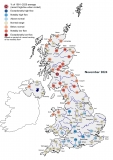Submitted by Steve Turner on
The gauging station on the river Thames at Kingston has been recognised by the World Meteorological Organization (WMO) for more than 100 years of hydrological observations. It has the longest continuous flow record associated with any UK gauging station, dating from 1883, meaning it has major historical and modern day significance.
The Environment Agency, which operates the gauging station, and the UK Centre for Ecology & Hydrology (UKCEH), which hosts the National River Flow Archive, put Kingston forward for recognition by the WMO.
The Kingston gauging station is the most downstream on the non-tidal river Thames. While originally measurements were taken at Teddington Weir the station moved to Kingston in 1974 and was upgraded in 2018 so it can continue to measure accurate river flows including the largest floods.
Long-term hydrological observations are important as they give us a foundation upon which water management is built. In the UK, as in most of the world, long-term trends in river flow and groundwater level underpin water management strategies and operational procedures that are designed to mitigate the problems caused by flooding or drought. These unique sources of past information allow us to study the natural variability in river flows and changes caused by mankind and climate change.
As a specialised agency of the United Nations, WMO supports international cooperation in the delivery and use of high-quality, authoritative weather, climate, hydrological and related environmental services by its Members. The WMO has a mechanism to recognise centennial observing stations in order to promote sustainable observational standards and best practices that facilitate the generation of high-quality time series data. While this mechanism in the past has included meteorological sites, in 2023 hydrological sites were recognised for the first time.
Professor Harry Dixon, Associate Director for International Research & Development at UKCEH, who is the UK Hydrological Adviser to WMO, said:
“River flow monitoring underpins our understanding of freshwater systems and our ability to manage the risks and opportunities they provide. It is excellent to see the sustained long-term environmental monitoring efforts of UK organisations recognised within the global community by the WMO.”
Kristie Caroli, from the Environment Agency said:
“We are proud that Kingston has been recognised as a long-term observing station. It is one of our most important sites in Thames area. We’ve invested significant resource to improve its resilience for the future. As a team we work hard to provide good quality data that is consistently accurate.”
Earlier this year, at the 19th World Meteorological Congress in Geneva, the WMO president, Abdulla Mandous, presented certificates to delegations from a total of 128 meteorological, hydrological or marine observing stations across the world that have been collecting data for more than 100 years.
The data from the Thames at Kingston are openly available on the National River Flow Archive. Flow and Level data for Kingston can also be downloaded from the gov.uk website. More information about the WMO Centennial Observation Stations is available on its website.

Thames at Teddington Weir (c) Jamie Hannaford, UKCEH



